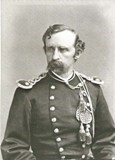|
Several frontier regiments had been created at the end of the Civil War, including the 7th Cavalry in 1866. At its peak, the 7th Cavalry numbered some 850 men. Over 40% of that number were foreign born with the majority born in Ireland or the German states. Although officially only second in command, the regiment was epitomized by its lieutenant colonel, George Armstrong Custer, the gallant and flamboyant Civil War hero. The 7th Cavalry was known for its esprit de corps, evidenced by its use of the jaunty Irish tune, “Garryowen” as its standard. Custer led the regiment in the attack on a Cheyenne village at the Washita in November 1868, through the Yellowstone Expedition of 1873, where the 7th engaged Lakota warriors on several occasions and the Black Hills Expedition of 1874, where the discovery of gold brought thousands to the Black Hills and led directly to the Sioux War of 1876-77. On May 17, 1876, over 900 men, including companies from the 6th and 17th Infantry regiments and the entire 7th Cavalry departed from their home outpost, Fort Abraham Lincoln, Dakota Territory as part of a three-pronged campaign designed to end the threat of the roaming Lakota and Cheyenne. Many were destined not to return. U.S. 7th CavalrySome Participants of the Battle of the Little Bighorn
Lt. Colonel George Armstrong CusterAfter his early education, George Armstrong Custer became a school teacher; soon he was accepted as a cadet at the United States Military Academy in West Point, New York and the rest is history. |
Last updated: March 17, 2023
